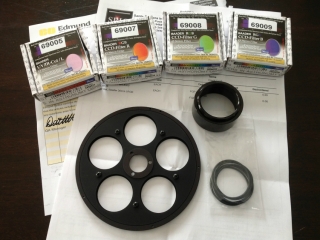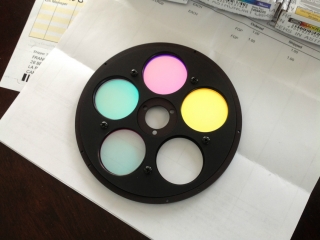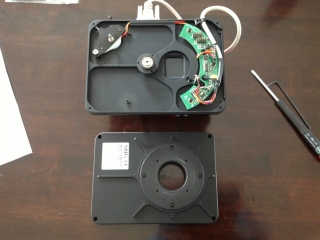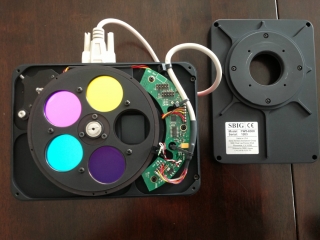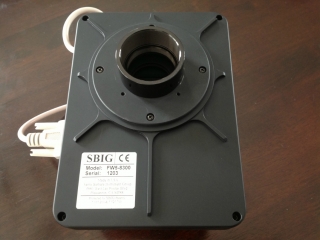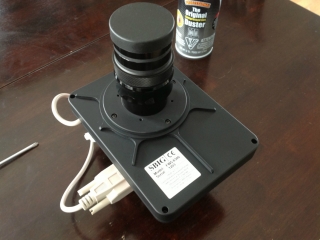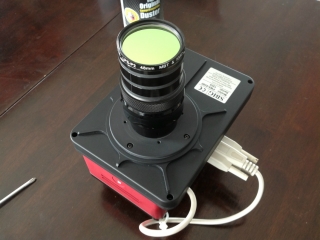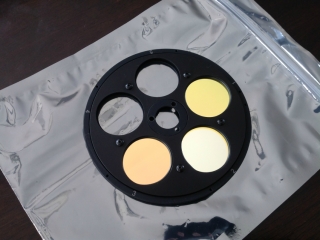I received the accessories for the SBIG ST-8300M
Today, I received the accessories I ordered earlier this week to finalize my new CCD camera setup. Here is what I received…
- 20mm T-Mount extension tube from Edmund.
- Extra filter carousel for the FW5-8300 filter wheel with 5 installation o-rings and
a set of 4 Baader LRGB 36mm unmounted filters from SBIG.
I started by installing the filters in the extra carousel. But before doing so, I did a search online to find out on which side to install the filters (i.e. anti-reflection coating facing the camera and not the telescope/sky). I found this thread on Cloudy Nights. According to an SBIG contact person, the base of the small V mark on the side of the filters should be pointing at the telescope/sky and not the camera. This should make sure the camera sensor do not get any reflections and that no halos can be seen around bright stars. Here you can see four of the five carousel slots equipped with the filters.
Clockwise from Lower left:
1 -Luminance
2- Red
3- Green
4- Blue
5 – Empty
Don’t be fooled by the colors on the picture. At an angle, these filters reflect wavelengths that are not the one they let through.
Here is what the interior of the filter wheel assembly look like without the carousel.
I then installed the carousel with the filters in the filter wheel.
After closing the filter wheel with its cover, I installed the 20mm T-Mount extension tube. This spacer should give the correct spacing between the camera sensor and the flange of the Hotech field flattener (i.e.~ 55mm). The camera and the filter wheel have 36.5mm of back focus; By adding the 20mm spacer, it places the camera sensor at 56.5mm distance of the field flattener which should allow me to obtain proper focus.
The Hotech field flattener screwed in.
The final touch was to install the IDAS LPS (Light Pollution Suppression) filter in front of the field flattener.
Wrap-up
- The LRGB filers will allow me to take color images with the ST-8300M monochrome camera.
- The Hotech field flattener should offer a flat image to the camera sensor for pinpoint stars across the entire field of view.
- The IDAS LPS should block the wavelengths emitted by the sodium and mercury lamps found in all the cities.
Also, the narrowband filters (i.e. Hydrogen alpha, Oxygen III and Sulfur II) will be useful later this summer when the Milky Way and its nebulas (planetary and emission) can be imaged in the east part of the sky that can be seen from the observatory. Here is a picture of the narrowband filters in their carousel.
Looking forward to put this new equipment to the test and produce better astronomical images.
Next steps
- Re-install the camera in the observatory.
- Shoot Bias calibration frames at fix temperature.
- Shoot Dark calibraiton frames at fix temperature and lenght.
- Test the flat illumination system in order to be able to shoot Flat calibration frames.
- Shoot G2V stars at the zenith to determine the proper white balancing ratios for these filters.
- Decide on the number and the duration of each sub-frames I am going to shoot to create these new color images.
Now, wish me luck so we can have many clear nights in the next months. I’ll post results as soon as I have any.
Thanks for reading.
Follow Clearskypix - 3D Printed Astronomy Parts and Accessories on Facebook.

